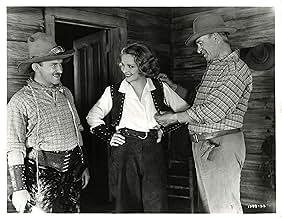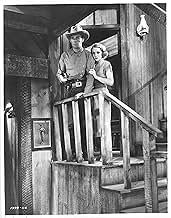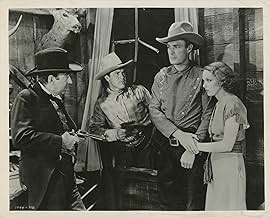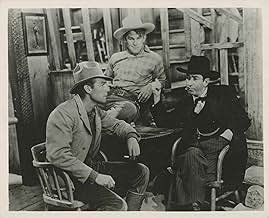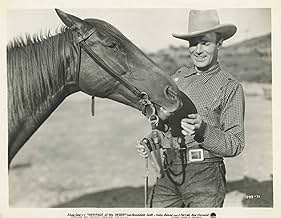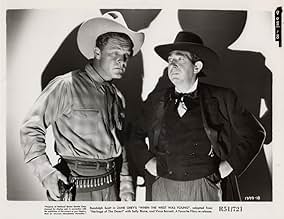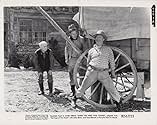Füge eine Handlung in deiner Sprache hinzuNabb controls the pass and lets all the ranchers through except Holderness and his stolen cattle. When Nabb refuses to sell, Holderness works an his son Snap who has run up gambling debts. T... Alles lesenNabb controls the pass and lets all the ranchers through except Holderness and his stolen cattle. When Nabb refuses to sell, Holderness works an his son Snap who has run up gambling debts. There is more trouble when Snap becomes jealous of Judy's attraction to the surveyor Jack. ... Alles lesenNabb controls the pass and lets all the ranchers through except Holderness and his stolen cattle. When Nabb refuses to sell, Holderness works an his son Snap who has run up gambling debts. There is more trouble when Snap becomes jealous of Judy's attraction to the surveyor Jack. When Holderness has Snap killed, everyone heads to town for the showdown.
- Regie
- Drehbuch
- Hauptbesetzung
- Lefty - Henchman
- (as Guinn Williams)
- Windy
- (as Vincent Barnett)
- Naab Man
- (Nicht genannt)
- Bob Burns
- (Nicht genannt)
- Ed Slade - Henchman
- (Nicht genannt)
- Barfly
- (Nicht genannt)
- Girl at Roulette Table
- (Nicht genannt)
- Naab Man
- (Nicht genannt)
- Cowhand
- (Nicht genannt)
- Henchman
- (Nicht genannt)
- Red - Henchman
- (Nicht genannt)
- Naab Man
- (Nicht genannt)
- Fred
- (Nicht genannt)
Empfohlene Bewertungen
Heritage Of The Desert one of the many Zane Grey novels that Paramount was filming during these years casts Randolph Scott as an eastern surveyor hired by J. Farrell MacDonald to get an accurate read on his boundary. That's something that neighboring rancher David Landau doesn't like probably because the result he knows would go against him.
Landau's our villain of the piece and is cut from the Snidely Whiplash mold which becomes abundantly clear when toward the end of the film he decides that he ought to marry Sally Blane who has no interest in him believe me. In fact that's the second part of the trouble Randy's walked into.
Blane is the daughter of MacDonald's late partner and she has a piece of the MacDonald spread outright. It's been assumed that she'd be marrying Gordon Westcott who is MacDonald's son. But Westcott's a weak sort who Landau has taken much advantage of. And until Scott arrives on the scene looking at what else was around, Blane probably thought she was getting a bargain.
So mix the elements of love and land feud and the answer is all's fair in love and range war.
It's very apparent that even cast as a somewhat green easterner Randolph Scott would have a good future in westerns. Blane's resemblance to her more well known sister Loretta Young is unmistakable and Landau is his usual villain, mean and tough and he does work through the more old fashioned aspects of his stock villain character.
And for double historical interest, Heritage Of The Desert is the first feature film directed by Henry Hathaway who was contracted to Paramount for many years starting with this film.
I'm sure the Saturday matinée crowd delighted in this one.
This is noted director Henry Hathaway breakout picture and he offers up some nice panoramas and carefully composed shots, which serve to give this movie its poetic or even dreamlike atmosphere. But, for the realist, the jumping from Joshua Tree-studded desert to oak woodlands to pine-studded ridge tops and back again in the confines of a local story is a bit hard to accept, unless one accepts being in a dream.
The story is involving, as one might expect, being that it is sourced from Zane Grey. It struck me that the delivery of the dialog was powerfully effective and engaging, so much so that it was disappointing to see the program come to a close. Why the story unfolded so satisfyingly was in large measure owing to the faces delivering it, which are diverse and fascinating, and to the voicing, which although admittedly delivered a little stiffly at times, is strong and consistently appropriate for each character.
The men in this story exist in a harsh and dangerous world, but this is contrasted with softness with the appearances of the very feminine Sally Blane. Sally's very non-1890 look is just one more example of the film's dreamlike demeanor. She of course photographs beautifully, including in the warm glow of a campfire's light. Deeper into the film Sally walks along a windswept rocky ridge studded with pine trees looking for Randolph in the softest of summer dresses, fluffing her hair as she anticipates seeing him. Obviously this scene couldn't be from real life! The soft-focus scene where the two "bed down" in the moonlight in close proximity to one another after having had a romantic day together, he in a bed of pine needles on the ground and she perched above him on a platform in a pine tree, is perhaps one of the most romantic of moments in cinematic history.
The film has plenty of great dialog. One fun passage occurs out of doors in a tree grotto when the villain Judd Holderness (actor Daniel Landau) tells one of the men under his thumb, in his ominously-toned voice, "I staked you to plenty, savvy? Maybe your old man would like to know what happened to his horse money!" The character Snap Naab replies nervously, "You wouldn't do a thing like that, would you?" Holderness kicks at the ground like a horse and replies sternly, "I do things like that every ten minutes." This is really great stuff, as they say!
For 1932, "Heritage of the Desert" is a slice above a standard B-western in budget and appointment, and even has some appreciated music, including a beautiful medley as backdrop in the bar scenes as well as non-intrusive scoring in well-up moments when romance or tension develop. In summary, "Heritage of the Desert" has a fine story; a strong romance story line; the requisite horse, gun play, and fistfight action; considered cinematography; and riveting dialog delivery. It is an excellent hour's worth of lush and dreamy western movie entertainment.
Into this mix comes surveyor Randolph Scott in his first starring western, under the direction of Henry Hathaway in his first credited appearance behind the megaphone. The result is mixed. The visuals are fine under the camerawork of Archie Stout, and the western atmosphere is a lot rawer and more realistic than many a director would have you believe. The Zane Grey story proceeds at a good clip. However, some of the performances are off and the line readings often too slow; Landau is particularly painful, and Scott seems to be absent from many of the scenes where he might have a line or two.
Well, star and director would improve quickly, and Vince Barnett as the comic relief is surprisingly painless. Guinn 'Big Boy' Williams is good in a henchman role. Still, it's more interesting for what the talent would later accomplish than it is on its own merits.
Veteran character actor J Farrell MacDonald gives one of his best performances here as Naab (unnecessarily weird name), a rancher who permits neighbouring ranchers to run their cattle drives through a narrow pass on his land ... all except rancher Judd Holderness (great name!), whom Naab knows to be a rustler. I usually dislike actor David Landau, with his coarse features and unpleasant voice, but here he has some great dialogue ... baiting his henchman Lefty with lines like 'How often have I told you not to think? You can do a lot better with your gun' and 'You got a six-gun where your brains oughta be.' When a morally ambiguous rancher (good performance by Gordon Westcott) tries to appeal to Holderness's conscience -- 'You wouldn't do a thing like that, would you?' -- Holderness calmly replies 'I do things like that every ten minutes.' Sally Blane, Loretta Young's sister, gives a strong and appealing performance as the heroine. I'm a fan of Loretta Young, but I've always found her just a little too beautiful to be believable in most of her roles. (I have the same problem with Nicole Kidman, whom I also like.) Blane strongly resembled her famous sister but was slightly less beautiful, and this makes her far more credible than Loretta in roles such as the one she plays here. Blane spends much of the film in a set of culottes which show off her lissome figure, but which are probably not historically accurate.
Vince Barnett, a character actor whom I usually like, is saddled here with some painfully thick-witted dialogue which he enunciates in one of the most bizarre and implausible accents I've ever heard. Randolph Scott is excellent as the surveyor who arrives at Naab's spread, where Sally shows interest in his plumb bob.
SPOILERS COMING. Hathaway's directorial hand is sure throughout. I was especially impressed by one staggeringly beautiful desertscape, and by a long series of dissolve shots as Randolph Scott's stand-in, wounded by a cowpoke's bullet, stumbles through the alkali.
Later in the film, there's an impressive sequence in which two characters draw their pistols and stand each other off. The camera pans to Sally Blane's reaction as two shots are fired off-camera. She screams, and we know that *somebody* got plugged ... but we don't learn the outcome until later.
Considering that this film was made on a low budget in 1932, its sound recording is very impressive. I'll rate 'Heritage of the Desert' 8 out of 10.
Wusstest du schon
- WissenswertesThe 20 Zane Grey stories sold by Paramount to Favorite Films for theatrical re-release, and then to Unity Television Corp. for television broadcast, are as follows: The Light of Western Stars (1930) (aka "Winning the West"), Fighting Caravans (1931) (aka "Blazing Arrows"), Heritage of the Desert (1932) (aka "When the West Was Young"), The Mysterious Rider (1933) (aka "The Fighting Phantom"), The Thundering Herd (1933) (aka "Buffalo Stampede"), Man of the Forest (1933) (aka "Challenge of the Frontier"), To the Last Man (1933) (aka "Law of Vengeance"), Wagon Wheels (1934) (aka "Caravans West"), Rocky Mountain Mystery (1935) (aka "The Fighting Westerner"), Drift Fence (1936) (aka "Texas Desperadoes"), Desert Gold (1936) (aka "Desert Storm"), The Arizona Raiders (1936) (aka "Bad Men of Arizona"), Arizona Mahoney (1936) (aka "Arizona Thunderbolt"), Unter falschem Namen (1937) (aka "River of Destiny"), Thunder Trail (1937) (aka "Thunder Pass"), Die Spielhölle von Wyoming (1937) (aka "Hell Town"), The Mysterious Rider (1938) (aka "Mark of the Avenger"), Heritage of the Desert (1939) (aka "Heritage of the Plains"), Knights of the Range (1940) (aka "Bad Men of Nevada"), The Light of Western Stars (1940) (aka "Border Renegade").
- PatzerThe story takes place in 1890, but Sally Blane's hairstyles, make-up and demeanor are strictly 1932, likewise the girls in the saloon.
- Zitate
Dance Hall Girl: Hello, Stranger
Jack Hare: How did you know I was a stranger?
Dance Hall Girl: Because I don't know you. Anybody I don't know is a stranger.
- VerbindungenFeatured in Golden Saddles, Silver Spurs (2000)
Top-Auswahl
Details
- Laufzeit
- 1 Std.(60 min)
- Farbe
- Seitenverhältnis
- 1.37 : 1

